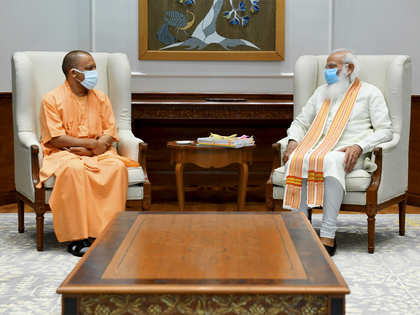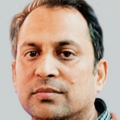 ANI
ANI
‘News’ of a supposed Adityanath-Modi tussle, the CM defying Modi’s wish to have retired bureaucrat Arvind Sharma, a brahmin, as deputy CM, and Ramdev and his various remarks against allopathy have helped BJP to divert attention from Covid-related challenges and miseries in UP.
UP may have relinquished its position as the ‘heartland’ to Gujarat — it’s been three decades since the former sent a prime minister to Delhi — but will it regain its dominance in national politics? Will current Chief Minister Adityanath manage to elevate himself as part of BJP’s national leadership if he wins another term in office?
There is much speculation about a so-called tussle between Adityanath and the prime minister in the middle of the second wave of Covid-19. This, especially after the state’s public healthcare system has been badly exposed, with images of bodies floating along rivers and found semi-buried along the Ganga and Yamuna — mostly in UP and also in other states like Bihar — becoming optics of the worst kind for India.
Which gives rise to a set of questions: is there disenchantment among BJP electorates in UP? Will Adityanath be able to get himself re-elected? Should he, a Rajput (thakur), be replaced to contain anti-incumbency by someone from the brahmin community currently disenchanted with the CM?
Speculation about Adityanath’s replacement during the pandemic is being compared in some circles to Narendra Modi being brought in after the 2001 Bhuj earthquake in Gujarat to replace chief minister Keshubhai Patel. The only difference is that in 2001, the diaspora-funded relief work was carried out by Sangh pracharaks along with property developers. The latter were rewarded with contracts in the urban reconstruction works that followed the earthquake. This, in turn, filled BJP election coffers, as described in Edward Simpson’s 2014 book, The Political Biography of an Earthquake: Aftermath and Amnesia in Gujarat, India.
In contrast, UP hasn’t demonstrated similar ‘pracharak dedication’ for Covid relief. Perceived state indifference to the indignity to the dead is a genuine grievance in UP, as attested by BJP’s not-so-good performance in local body elections. But, remember, despite having done everything to contain anti-incumbency, BJP in Gujarat went into the 2002 elections with another burning issue: the 2002 riots fuelled by Hindu right-wing mobilisation and consolidation.
What lesson BJP may want to learn in the run-up to UP 2022 from Gujarat 2002 will be evident in the next few months. But there are signs of majoritarian consolidation already manifesting. The series of events last month, which included the demolition of an old mosque in Barabanki in violation of an Allahabad High Court order, the killing of a Muslim vegetable vendor in Unnao reportedly by policemen and ‘cow vigilantes’ grievously beating up a Muslim boy in Moradabad, may be read as signs of a pre-election groundswell.
While the proportion of Muslim representation in the recently concluded local body elections in UP is yet to be obtained, enhanced representation of Muslims can lead to Hindu consolidation. This was one of the factors in the 2017 local body elections, especially in western UP. Then there is what Sudha Pai and Sajjan Kumar term ‘everyday communalism’ in their eponymous 2018 book on UP riots, that has been at play since at least 2013. This refers to the majoritarian strategy that replaces large-scale violence targeting Muslims with a sustained and scattered low-scale communal tension to create fear among Muslims.
‘News’ of a supposed Adityanath-Modi tussle, the CM defying Modi’s wish to have retired bureaucrat Arvind Sharma, a brahmin, as deputy CM, and Ramdev and his various remarks against allopathy have helped BJP to divert attention from Covid-related challenges and miseries in UP. Will this politics of diversion really help BJP contain Adityanath’s anti-incumbency?
‘Discussions’ on social media are increasingly spilling over into the physical spaces of village and mohalla gossips, which, despite the ongoing farmers’ protests, may also be helping to play down peasant grievances. Aggressive right-wing politics may, thus, be helping dilute any anti-Adityanath resentment. Regardless of its electoral prospects in the face of Covid — tackling a ravaged economy, mounting unemployment and naked profiteering — it seems inevitable that BJP will resort to pushing the foot down harder on the pedal of communal politics. To consider this as a mere bogey would be to be in denial.
The writer is professor of history, Aligarh Muslim University










 Get Unlimited Access to The Economic Times
Get Unlimited Access to The Economic Times
